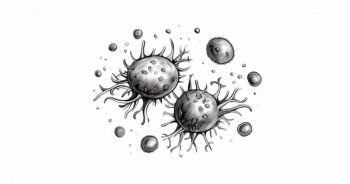
Peers & Perspectives in Oncology
- May 2025
- Pages: 20
Seiter Explores Time of Initiation and Alternate Dosing of Ruxolitinib in Myelofibrosis
During a live event, Karen Seiter, MD, discussed the role of the JAK/STAT pathway in myeloproliferative neoplasms and the use of ruxolitinib to treat myelofibrosis.
CASE SUMMARY
- A 68-year-old woman presented to her physician with symptoms of mild fatigue.
- Spleen was palpable 6 to 7 cm below the left costal margin
- Past medical history: no known comorbidities
- Next-generation sequencing testing: JAK2 V617F mutation
- Karyotype: 46,XX
- Bone marrow biopsy: megakaryocyte proliferation and atypia with evidence of reticulin fibrosis
- Blood smear: leukoerythroblastosis
- Diagnosis: primary myelofibrosis
Risk
- Dynamic International Prognostic Scoring System: intermediate-1
- Mutation-Enhanced International Prognostic Scoring System for Transplantation-Age Patients: intermediate risk
Laboratory Values
- Red blood cell count: 3.40 ×106/μL
- Hemoglobin level: 9.7 g/dL
- Hematocrit: 32.3%
- Mean corpuscular volume: 94 μm3
- White blood cell count: 23,000/μL
- Platelet count: 450,000/μL
- Peripheral blood blasts: <1%
Peers & Perspectives in Oncology: What disease states are currently classified as myeloproliferative neoplasms (MPNs)?
Seiter: The latest classification is the 2022 World Health Organization [WHO] classification.1,2 As a clinician, when we have myeloproliferative diseases, we think of MPNs [as meaning the patient] has too much of something: The WBC count is too high but with maturing myeloid and not with a lot of blasts, or the hemoglobin [level] is too high, or the [platelet count is] too high. That would be potentially chronic myelocytic leukemia [CML], polycythemia vera [PV], essential thrombocytopenia [ET], and for primary myelofibrosis, the most common presentation would be somebody with either anemia, with abdominal distension or early satiety from splenomegaly. The WBC count could be high; it could be low; platelets could be high, or they could be low.
When we’re working up patients with MPN, the first step is always to make sure that they don’t have CML, because CML can look like myelofibrosis because CML can present with a high platelet count. The first step is always to [test for] the Philadelphia chromosome and perform BCR::ABL1 testing to make sure it’s not CML.
Most of these patients are going to have a bone marrow [biopsy] done. There’s always the debate about, if you have somebody with a hemoglobin level of 20 g/dL, where it looks pretty clear that they have PV, do you need a bone marrow [biopsy] in order to formally diagnose the patient? You do because that’s part of the diagnostic criteria. But sometimes, if you have a much older patient with frailty, you have to consider the goals of care. Sometimes, there may be cases of patients who don’t get the bone marrow biopsy done. The only time it would be reasonable is if the hemoglobin level is high; for anything else, there are so many other things that [it] could be that it’s important to do the bone marrow biopsy for a diagnosis.
Mastocytosis used to be [listed among the] MPNs, but [the WHO] made it its own classification. MPNs with eosinophilia are a separate category. Now we have the myelodysplastic syndrome [MDS]/MPN overlap; that’s a separate category. Then, we have MDS, secondary myeloid neoplasms, and acute myeloid leukemia.
What is the role of the JAK/STAT pathway and its mutations in MPNs?
In terms of the Philadelphia chromosome–negative myeloproliferative diseases, the JAK/STAT pathway is the driving force of these diseases, and in many of them, that’s due to a JAK2 mutation.3,4 However, even in the diseases in which JAK2 is not mutated, usually the disease is driven through the JAK2 pathway because the other mutations that we see, CALR and MPL, come together in the JAK/STAT pathway. It’s the same signaling pathway, even if you don’t have the JAK2 mutation.
In terms of PV, 95% of patients are going to have a JAK2 mutation. That always made things very easy. There are a number of other things that can make your hemoglobin level high, and years ago, that was a big pain because you had to do a lot of tests to distinguish primary from secondary, but now it’s so easy: 95% of the people are going to have a JAK2 mutation. If they don’t have a JAK2 mutation, it’s more likely to be a secondary erythrocytosis.
In terms of ET, about half the patients will have a JAK2 mutation, and then the next most common would be a CALR mutation with a small percentage of MPL. For primary myelofibrosis, a little more than 60% will have a JAK2 mutation; some will have a CALR; and some will have a MPL. We do have a small percentage of patients who we call triple negative because they don’t have any of these 3 major mutations. Those tend to have a worse prognosis. They may have other mutations such as ASXL1 or some of these other myeloid mutations, but they tend to have a worse prognosis.
How are JAK inhibitors used to treat myelofibrosis?
We now have 4 drugs that are FDA approved that target JAK2 in the hematology world. Rheumatology uses a lot of JAK inhibitors, too, but they use other drugs that are different from the ones that we use.
The first one approved was ruxolitinib [Jakafi], and the 4 drugs all inhibit JAK2.5 But the main difference between the 4 drugs is, none of these drugs are pure JAK2 inhibitors. They inhibit other molecules and pathways. Depending on whatever else they inhibit, that’s where you get some of the differences between the drugs. Ruxolitinib is a strong inhibitor of JAK2 but also inhibits JAK1. Fedratinib [Inrebic] has a little less activity against JAK1. Momelotinib [Ojjaara] inhibits both pathways but also inhibits ACVR1. And pacritinib [Vonjo] does not have an effect on JAK1 but has an effect on ACVR1. ACVR1 is a molecule that’s involved in bone metabolism, but it also ties in with the hepcidin pathway, so that seems to be the link between this molecule and the hematology world.
What impact do baseline cytopenias have on the treatment of myelofibrosis?
There are patients who present with high blood counts when you have myelofibrosis, and then there are patients who present with low blood counts. Some people have called this cytopenic myelofibrosis, although that’s not really a formal diagnosis—it is more of a clinical description. If you have cytopenic myelofibrosis, the prognosis tends to be worse, and that could be from a number of different things.6 One, it could be the disease itself is more aggressive. Two, maybe they’ve had the disease for a longer period of time before it was diagnosed or before it was treated. Three, when you’re starting out with these cytopenias, it makes it harder to treat the patient because JAK2 is important in normal hematopoiesis. If you’re blocking JAK2, you’re suppressing some normal blood counts as well. If you’re starting out with low counts, it’s harder to treat these patients because it’s harder to get the drugs into them. There are a number of different reasons why the prognosis is worse with cytopenias.
How do the NCCN guidelines advise the use of JAK inhibitors?
These NCCN guidelines are for higher-risk patients. The first breakdown is [based on] what the platelet count is, because if the patient’s platelet count is less than 50,000/μL, then you have to [make] so many dose reductions of the drugs that it’s like you’re not getting the drugs [into the patient].
If you consider whether they’re a transplant candidate, you can send them straight to transplant. If they’re not a transplant candidate, then pacritinib gets a category 1 [recommendation] from NCCN, and we have some data to show that pacritinib has activity in terms of spleen reduction but has less effect on platelets so patients with lower platelet counts can maybe do better with pacritinib.
If you’re starting with a reasonable platelet count, more than 50,000/μL, then you have the options of the 4 drugs where ruxolitinib is category 1 and the most commonly used from long-term experience. Fedratinib is also category 1, or you could use momelotinib. Pacritinib is category 2B. It’s out there, but it’s usually reserved for people starting out with low platelet counts or for patients who’ve [been on] another drug and need to change to a different drug.
Then, you typically monitor for signs and symptoms of progression. If the patient is responding, continue what you’re doing. If they’re not responding, then you can change to one of the other drugs, or reevaluate for transplant and then for disease progression. If they’re going to the accelerated or blastic phase, then we usually will add some form of hypomethylating agent or chemotherapy to that.
Could you describe the outcomes of the trials of ruxolitinib?
The COMFORT I [NCT00952289] and COMFORT II [NCT00934544] studies led to the initial approval of ruxolitinib. COMFORT I is for ruxolitinib vs placebo in previously untreated patients. There were no other FDA-approved drugs at that point. Then we have [COMFORT II] of ruxolitinib vs best available therapy, which for the most part, were patients who were continuing on hydroxyurea.
When these trials were initially published, the focus was on reduction in spleen size because that was the most obvious thing that we saw when giving this drug. Reduction in spleen size, although it can help with the patient’s symptoms and it can potentially help with their blood counts over time if you’re reducing the spleen, in my opinion, is not the most important end point. For me, overall survival [OS] is the most important end point, but the reduction in spleen size is a surrogate marker for OS. Patients who have these reductions and responses tend to live longer.
For COMFORT I, the 5-year OS [outcomes were that] there were 44% deaths on ruxolitinib vs 53% on placebo [HR, 0.69; 95% CI, 0.50-0.96; nominal P = .025], and there was also a significant difference in OS for the COMFORT-2 study.7,8 It shows that you are having a disease-modifying effect by reducing the risk of death from the disease.
After the study was performed, they pulled the data from the 2 trials to go back and analyze the different risk groups. One thing they looked at was, how did patients do if they started ruxolitinib within a year of diagnosis vs more than a year after diagnosis, and starting the drug early was the most important prognostic factor associated with survival. This came out in a multivariate analysis [OR, 2.075; 95% CI, 1.117-3.898].9
All the different outcomes were improved if you started ruxolitinib sooner. Change in spleen volume, total symptom score, and the percentage of patients with a reduction in spleen volume were all better if you started [ruxolitinib] within 1 year of diagnosis, compared with waiting [Figure9].
What data support an alternate dosing strategy for ruxolitinib?
This is the REALISE trial [NCT02966353]. It’s a trial from Europe. I see a lot of patients who are not really getting the dose that the FDA approved. The dosing of ruxolitinib is based on the initial platelet count, and sometimes I see patients who start at very low doses, and they are left at very low doses, and then they’re not responding. But in Europe, they decided to try starting with a lower dose, 10 mg twice daily, and then titrating up, trying to push the dose up as high as you could go based on the patient’s platelet count. They would start with 10 mg twice daily, and at week 12, look at what the patient’s platelet count is and their response, go up to 15 mg twice daily, and then do the same thing a few weeks later and go up [to a target of 25 mg twice daily].
Over time, they were able to get the dose up high in the majority of patients.10 This is starting slow and building up, which is the opposite of what the approved dosing is, but they were able to show a very good spleen response. Approximately 70% of patients had a 35% reduction in spleen size, and most of the patients had an improvement in symptom response. The outcomes were good with this approach. It’s not the FDA-approved dosing, but it’s an alternate approach.
They also looked at transfusion requirements. By using this slow and steady raising of the dose, over time the number of patients with transfusion dependence went down, whereas if you were not transfusion dependent, a couple of patients did become transfusion dependent a couple of months in, but then it tends to get better again. This is typical with ruxolitinib where you will get some reduction in the hemoglobin [level] initially, and then, usually after about 2 months, it starts to come back up and then gets better.
Some of the adverse events that were noted [in the REALISE trial] were anemia [in 35.3%], thrombocytopenia [in 29.4%], elevated liver function tests [in 9.8%], diarrhea [in 11.8%], fatigue [in 9.8%] and urinary tract infections [in 9.8%].
DISCLOSURES: Seiter previously disclosed research funding and consulting fees from Bristol Myers Squibb.








































